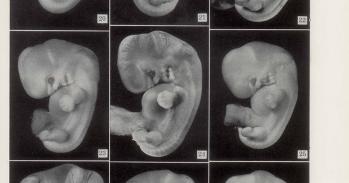
The process by which a mother’s diet during pregnancy can permanently affect her offspring’s attributes, such as weight, could be strongly influenced by genetic variation in an unexpected part of the genome, according to research published today. The discovery could shed light on why many human genetic studies have previously not been able to fully explain how certain diseases, such as type 2 diabetes and obesity, are inherited.
The process by which a mother’s diet during pregnancy can permanently affect her offspring’s attributes, such as weight, could be strongly influenced by genetic variation in an unexpected part of the genome, according to research published today. The discovery could shed light on why many human genetic studies have previously not been able to fully explain how certain diseases, such as type 2 diabetes and obesity, are inherited.
The study, published in Science by researchers at University of Cambridge, Queen Mary University of London (QMUL) and King’s College London, shows that the genetic variation of ribosomal DNA (rDNA) could be driving how the environment within the womb determines an offspring’s attributes. rDNA is the genetic material that forms ribosomes - the protein building machines within the cell.
Lead researcher Professor Vardhman Rakyan from QMUL said: “The fact that genetic variation of ribosomal DNA seems to play such a major role suggests that many human genetics studies in humans could be missing a key part of the puzzle. These studies only looked at a single copy part of individuals’ genomes and never at ribosomal DNA.
“This could be the reason why we’ve only so far been able to explain a small fraction of the heritability of many health conditions, which makes a lot of sense in the context of metabolic diseases, such as type 2 diabetes.”
The environmental factors that play a role alongside genetic factors in determining a person’s attributes are also present in the in-utero environment. When offspring are in the womb, the environment experienced by their mothers (for example, diet, stress, smoking), influences the attributes of their offspring when they are adults. This ‘developmental programming’ is thought to contribute to the obesity and type 2 diabetes epidemic seen today.
A major contributor to this process is ‘epigenetics’. This describes naturally-occurring modifications to genes that control how they are expressed. One such modification involves tagging DNA with chemical compounds called methyl groups. These epigenetic markers determine which genes are expressed or not expressed. Liver cells and kidney cells are genetically identical in terms of their DNA sequence but differ in their epigenetic marks. It has been proposed that in response to a poor in-utero environment, an offspring’s epigenetic profile will change.
The team compared the offspring of pregnant mice when given a low protein diet (8 per cent protein) and a normal diet (20 per cent protein). After they were weaned, all offspring were given a normal diet, and the team then looked at the difference in the offspring’s DNA methylation, from mothers exposed to a low protein diet and those that were not.
Professor Rakyan said: “When cells are stressed, for example when nutrient levels are low, they alter protein production as a survival strategy. In our low protein mice mothers, we saw that their offspring had methylated rDNA. This slowed the expression of their rDNA, which could be influencing the function of ribosomes, and resulted in smaller offspring – as much as 25 per cent lighter.”
These epigenetic effects occur during a critical developmental window while the offspring is in-utero but is a permanent effect that remains into adulthood. A mother’s diet while pregnant is therefore likely to have more severe consequence on the offspring’s epigenetic state than an offspring’s own diet after it has been weaned.
Professor Susan Ozanne from the University of Cambridge Metabolic Research Laboratories and MRC Metabolic Diseases Unit added: “Perhaps our most surprising finding was that, despite all of our mice being bred to be genetically identical, their rDNA was different. In fact, even within an individual mouse, different copies of rDNA were genetically distinct."
In any given genome, there are many copies of rDNA, and the researchers found that not all copies of the rDNA were responding in the same way epigenetically. In offspring from mothers who were fed a low protein diet, it was only one form of rDNA – the ‘A-variant’ - that appeared to undergo methylation and affect weight. Professor Ozanne added: “This variation in rDNA appears to be playing a large role in determining the response of the fetus to the in utero environment and therefore its phenotype later in life.”
This means that the epigenetic response of a given mouse is determined by the genetic variation of the rDNA - those who have more A-variant rDNA end up being smaller.
Heritability (how much the risk of a disease is explained by genetic factors) of type 2 diabetes has been estimated to be between 25 and 80 per cent in different studies. However, less than 20 per cent of the heritability of type 2 diabetes has been explained by genome studies of people with the disease. The major role played by genetic variation of rDNA, together with the fact that rDNA analysis would not have been included in these studies, could explain some of this missing heritability.
The findings also complement other studies that have found that mice that are put on high fat diets have offspring who show increased rDNA methylation. This suggests that methylation is a general stress response and may also explain the rise in obesity that is happening across the world.
The study was funded by the Biotechnology and Biological Sciences Research Council, Research Councils UK, the European Union, British Heart Foundation and Medical Research Council.
Reference
Holland, ML et al. Early life nutrition modulates the epigenetic state of specific rDNA genetic variants in mice. Science; 7 July 2016; DOI: 10.1126/science.aaf7040
Adapted from a press release from Queen Mary University of London

The text in this work is licensed under a Creative Commons Attribution 4.0 International License. For image use please see separate credits above.




